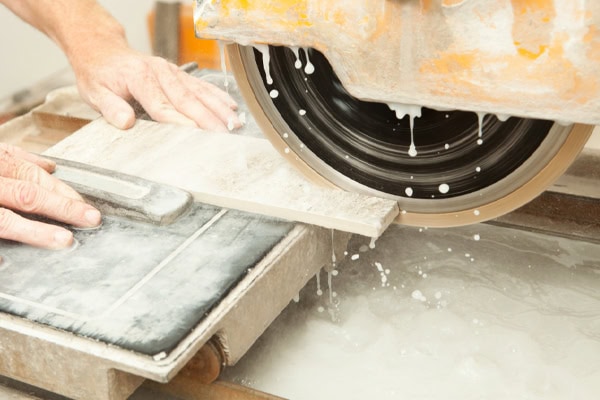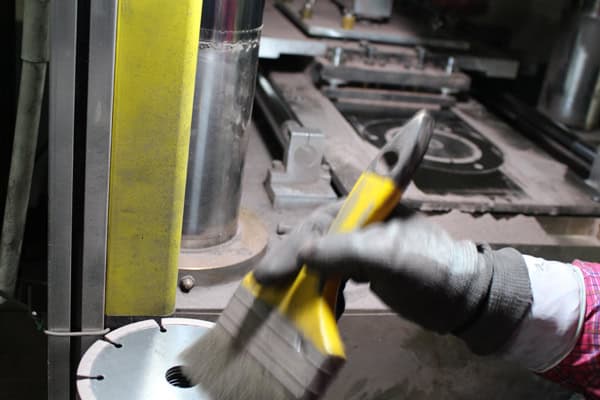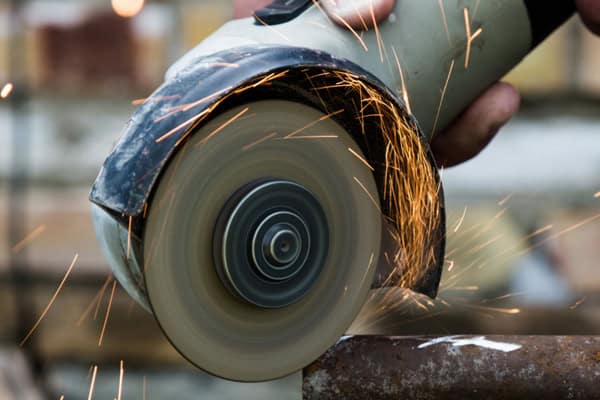I remember the first time I tried cutting porcelain tile. I grabbed my trusty circular saw, fitted with what I thought was a suitable blade. The result was a chipped, uneven edge that ruined my project and a wasted tile. That’s when I learned the hard way and discovered the importance of using the right blade – a diamond blade.
Yes, you can cut porcelain tile with a circular saw, but only if you equip it with a diamond blade specifically designed for tile cutting. The circular saw provides the power, but the diamond blade delivers the clean, precise cuts needed to avoid chipping the delicate porcelain surface.

Using a circular saw1 for porcelain tile cutting requires special attention to both the tool and technique. Let me explain why diamond blades2 are essential, how to choose the right one for your circular saw, and some tips I’ve picked up over the years to achieve professional results3.
What Is a Diamond Blade Good For?
Diamonds are the hardest known natural material4 on earth. This extreme hardness5 makes them ideal for cutting through materials that would quickly dull or destroy regular blades.
Diamond blades excel at cutting extremely hard materials like concrete, stone, porcelain, ceramic, and glass. Instead of relying on sharp teeth to saw through the material, diamond blades use diamond particles to grind it away, resulting in a cleaner and more controlled cut.

Understanding Diamond Blade Applications
Most professionals, including myself, keep a variety of diamond blades on hand. Each is designed for a specific material and cutting task. Here’s a breakdown of why this specialization is important:
| Material | Blade Type | Cutting Speed | Expected Lifespan |
|---|---|---|---|
| Concrete | Segmented | Fast | 30-50 cuts |
| Porcelain | Continuous rim | Slow | 20-30 cuts |
| Granite | Turbo rim | Medium | 15-25 cuts |
| Asphalt | Segmented | Very fast | 60-80 cuts |
The key difference between these blades lies in the bond strength6 of the metal matrix holding the diamonds. Softer materials require a softer bond that allows the diamonds to be exposed gradually as the blade wears. Harder materials need a stronger bond to prevent the diamonds from being pulled out prematurely. Using the wrong blade on your circular saw can lead to inefficient cutting, blade damage, and poor results.
The Different Applications for Diamond Blades
Contractors often ask me if they can use a single diamond blade for all their cutting needs. While that would be convenient, it’s not practical due to the diverse properties of different materials.
Specialized diamond blades are available for concrete, tile, masonry, asphalt, and stone cutting. Each type features a unique segment design, diamond concentration, and bond strength tailored to the specific demands of the material it’s intended to cut when used with tools like a circular saw.

Choosing the Right Diamond Blade for Your Circular Saw
Based on my experience, I strongly recommend considering these factors when selecting a diamond blade for your circular saw. Doing so can save you time, money, and a great deal of frustration:
- Material hardness: Granite demands a different blade than softer limestone.
- Cutting method: Wet cutting (using a wet saw or a circular saw with a water attachment) extends blade life and minimizes dust. Dry cutting is more convenient but generates more heat.
- Saw type: The arbor size (the hole in the center of the blade) must match your circular saw. Also, consider the saw’s power and RPM (revolutions per minute).
- Cut quality: Smooth, chip-free cuts on tile require continuous rim blades. Segmented blades are better for faster, rougher cuts on concrete or stone.
- Cutting speed: Turbo blades cut faster but can generate more heat, so they may not be ideal for delicate materials.
For porcelain tile, always choose a continuous rim diamond blade7 specifically designed for tile work and ensure it fits your circular saw. These blades minimize chipping, which is vital for achieving a professional-looking result. Using a wet saw or a circular saw with a water-cooling attachment8 is highly recommended to keep the blade cool and reduce dust.
How Are Diamond Saw Blades Made?
When I first toured our factory’s diamond blade production line, I was amazed by the precision and complexity involved. Creating these cutting tools is a far cry from simply gluing diamonds onto metal.
Diamond blades are manufactured by carefully mixing diamond particles with powdered metal and then bonding this mixture to a steel core using high heat and pressure. The diamond concentration and the type of bond used determine the blade’s cutting characteristics and its suitability for different materials and tools like circular saws.

The Manufacturing Process Explained
Here’s a step-by-step overview of the process we use in our factory to produce high-quality diamond blades:
-
Core Preparation
- Steel centers are laser-cut for precise dimensions.
- The core is precision-balanced to minimize vibration during use with your circular saw.
- The surface is treated to ensure a strong bond with the diamond segments.
-
Segment Production
- Diamond powder is meticulously mixed with various metal powders.
- The mixture is cold-pressed into the desired segment shapes.
- The diamond concentration and metal powder composition are precisely controlled to achieve the desired cutting properties.
-
Bonding Process
- The segments are precisely positioned onto the steel core.
- High-temperature sintering in a controlled atmosphere furnace bonds the segments to the core.
- Rigorous quality inspection ensures that the segments are securely attached and properly aligned for safe and effective use with your circular saw.
-
Finishing Steps
- Segment sharpening exposes the diamond particles for optimal cutting performance.
- Final balancing eliminates any remaining vibration.
- Performance testing verifies that each blade meets our strict quality standards.
At our factory, we use only premium-grade diamonds9 and advanced sintering technology10 to guarantee consistent quality and performance. Every batch of blades undergoes thorough testing before being shipped to our customers. This commitment to excellence sets our blades apart and ensures they deliver reliable results with tools like your circular saw.
Can You Use a Diamond Blade to Cut through Metal?
This question comes up frequently at trade shows and online. From my experience, I always advise against it, unless you’re using a specialized blade designed for a specific metal-cutting application.
Diamond blades are generally unsuitable for cutting metal with a circular saw. The properties of metal, such as its hardness and its tendency to generate heat, can quickly damage the diamond segments of the blade, rendering it ineffective or even causing it to fail catastrophically. Using the wrong blade on your circular saw can be dangerous.

Why Diamond Blades and Metal Don’t Mix When Using a Circular Saw
Throughout my years in the hardware tool business, I’ve learned several key reasons why using diamond blades on metal with a circular saw is a bad idea:
- Heat Buildup: Metal generates significant heat when cut. This heat can soften or melt the bonding material holding the diamond segments, causing them to detach from the blade.
- Blade Wear: The hardness of many metals causes rapid and excessive wear on the diamond particles, dulling the blade and reducing its cutting efficiency.
- Safety Concerns: Attempting to cut metal with a diamond blade not designed for it can lead to blade cracking, warping, or shattering. Projectiles from a failing blade can cause serious injury when using a powerful tool like a circular saw.
For cutting metal with a circular saw or other power tools, it’s always best to use tools specifically designed for the task. Abrasive metal cutting discs11, high-speed steel blades12, or carbide-tipped saw blades13 are much better choices. These tools are engineered to handle the heat and friction associated with metal cutting, ensuring a clean, efficient, and safe cut.
Conclusion
Using the right diamond blade with your circular saw makes all the difference when cutting porcelain tile or other hard materials. But remember that diamond blades are not a one-size-fits-all solution. Always choose the right tool for the job to ensure safety and achieve the best possible results.
-
This resource will provide you with detailed techniques and safety tips for effectively using a circular saw on porcelain tiles. ↩
-
Exploring this link will help you understand the types of diamond blades available and their specific uses for porcelain tile cutting. ↩
-
Discover expert techniques and tips that can elevate your tile cutting skills to a professional level, ensuring high-quality finishes. ↩
-
Discover the fascinating properties and uses of the hardest known natural material, diamonds, and their significance in various industries. ↩
-
Explore how extreme hardness in materials like diamonds is utilized in cutting tools and other applications, enhancing efficiency and durability. ↩
-
Understanding bond strength is crucial for selecting the right diamond blade for your cutting needs, ensuring efficiency and longevity. ↩
-
Understanding the features and benefits of a continuous rim diamond blade can enhance your tile cutting skills and results. ↩
-
Learning about water-cooling attachments can help you reduce dust and prolong the life of your blades during tile cutting. ↩
-
Exploring this resource will provide insights into the advantages of premium-grade diamonds, enhancing your understanding of their value in manufacturing processes. ↩
-
This link will help you understand how advanced sintering technology enhances product quality, which is crucial for manufacturing excellence. ↩
-
Explore the advantages of abrasive metal cutting discs for efficient and safe metal cutting. ↩
-
Learn how high-speed steel blades enhance cutting performance and durability in metalwork. ↩
-
Discover why carbide-tipped saw blades are preferred for metal cutting due to their strength and longevity. ↩